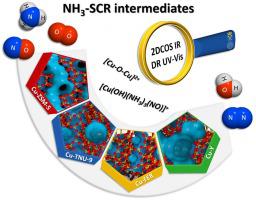Applied Catalysis B: Environment and Energy ( IF 22.1 ) Pub Date : 2020-11-22 , DOI: 10.1016/j.apcatb.2020.119752 Karolina A. Tarach , Magdalena Jabłońska , Kamila Pyra , Michael Liebau , Bastian Reiprich , Roger Gläser , Kinga Góra-Marek

|
The catalytic activity and stability of Cu-exchanged zeolites Cu-ZSM-5 (MFI topology), Cu-TNU-9 (TUN), Cu-FER (FER) and steamed Cu-Y (FAU) were evaluated in the selective catalytic NO reduction by ammonia (NH3-SCR). The NH3-SCR activity of the investigated catalysts strongly depended on the feed composition, i.e., the presence of H2O (5.0 Vol.-% of H2O). The catalysts revealed high stability during 24 h of NH3-SCR reaction, also in the presence of water vapour. DR UV–vis and FT-IR with probe molecules (CO or NO) showed the presence of isolated Cu+/Cu2+ and aggregated copper oxide species. Although Cu-ZSM-5 is less active than Cu-TNU-9 in catalysing NO oxidation to NO2, both catalysts revealed similar activity in the NH3-SCR reaction. Applying Rapid-Scan FT-IR spectroscopy and 2D COS analysis the reaction mechanism of NH3-SCR on Cu-exchanged zeolites was investigated. It is proposed that NH3-SCR over the studied Cu-exchanged catalysts proceeds via [Cu(OH)(NH3)2(NO)]+ intermediates followed by the reduction of Cu(II) to Cu(I). The differentiated speciation of copper sites is reflected in their various susceptibility for the reduction and finally affects the catalytic activity and stability of the zeolitic catalysts. The formation of the [Cu(OH)(NH3)2(NO)]+ mixed ligand species is governed by the competition between the O2− and NH3 ligands. Also the stability of the forms initiating NH3-SCR, i.e., [Cu(NH3)4]2+, [Cu(OH)(NH3)3]+ and [Cu(NH3)2]+, is ruled by the confine interaction of ammonia molecules, which can be both adsorbed on a protonic site and ligated to copper sites with the framework oxygen atoms.
中文翻译:

沸石拓扑结构对NH 3 -SCR活性和Cu交换沸石稳定性的影响
在选择性催化NO中评估了Cu交换沸石Cu-ZSM-5(MFI拓扑),Cu-TNU-9(TUN),Cu-FER(FER)和蒸煮Cu-Y(FAU)的催化活性和稳定性。氨(NH 3 -SCR)还原。的NH 3被调查催化剂的活性-SCR强烈依赖于进料组合物,即。,H的存在2 O(5.0体积.- H的%2 O)。在水蒸气的存在下,催化剂在NH 3 -SCR反应的24小时内显示出高稳定性。带有探针分子(CO或NO)的DR UV-vis和FT-IR表明存在分离的Cu + / Cu 2+和聚集的氧化铜物质。尽管Cu-ZSM-5在催化NO氧化为NO 2方面的活性不如Cu-TNU-9 ,但两种催化剂在NH 3 -SCR反应中均表现出相似的活性。应用快速扫描红外光谱和二维COS分析,研究了NH 3 -SCR在Cu交换沸石上的反应机理。建议在研究的铜交换催化剂上通过[Cu(OH)(NH 3)2(NO)] +进行NH 3 -SCR反应中间体,然后将Cu(II)还原为Cu(I)。铜位的不同形态反映在它们对还原的各种敏感性中,并最终影响沸石催化剂的催化活性和稳定性。[Cu(OH)(NH 3)2(NO)] +混合配体的形成受O 2-和NH 3配体之间的竞争支配。同样,引发NH 3 -SCR的形式的稳定性,即[Cu(NH 3)4 ] 2 +,[Cu(OH)(NH 3)3 ] +和[Cu(NH 3)2 ] +是由氨分子的有限相互作用决定的,氨分子既可以吸附在质子位点上,也可以与骨架氧原子连接到铜位点上。



























 京公网安备 11010802027423号
京公网安备 11010802027423号